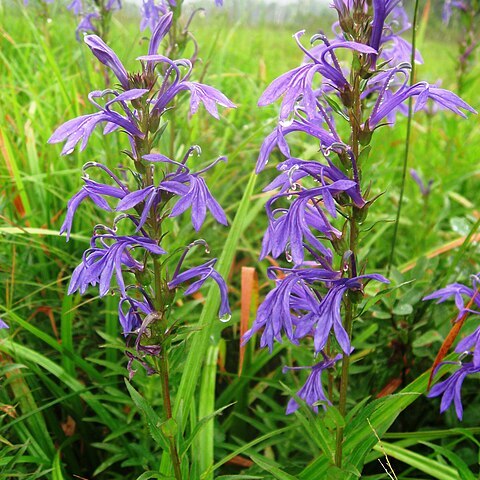Herbs, perennial, 20-170 cm tall. Stems simple, glabrous. Leaves alternate, larger at middle part of stem, thickly papery, sessile; blade lanceolate, narrowly oblong, or narrowly elliptic, 1.8-9 × 0.2-2.2 cm, both surfaces glabrous, base rounded, truncate, obtuse, or cuneate, margin serrulate, apex acute or acuminate. Racemes terminal, 8-35-flowered, glabrous; bracts leaflike, lanceolate or narrowly elliptic, shorter than flowers but longer than pedicels; pedicels 5-24 mm, ebracteolate. Hypanthium campanulate, hemispheric, ellipsoid, obovoid, or obconic, 3-7 mm, glabrous; calyx lobes subulate or narrowly triangular, 4.5-12 × 1-3 mm, glabrous, margin entire, revolute. Corolla blue-purple or violet, 2.5-3.7 cm, 2-lipped, outside glabrous, inside villous; upper 2 lobes ascending, spatulate, 10-20 × 1.5-4 mm, equaling or longer than corolla tube; lower lobes elliptic, 10-21 × 2.3-6.5 mm, nearly as long as corolla tube, densely long ciliate. Stamens connate above base; filament tube glabrous; anther tube 4-6 mm, glabrous or villous along upper sutures toward apex; lower 2 anthers barbate at top. Capsule obovoid, broadly ellipsoid, or globose, 7-15 × 5-11.5 mm. Seeds brown-red, oblong or ellipsoid, 1.3-2 mm, terete but winged on one side, finely striate. Fl. and fr. Jul-Oct.
More
A herb. It keeps growing from year to year. It grows 20-170 cm tall. The leaves are alternate. They are narrowly oblong and 2-9 cm long by 1-2 cm wide. There are teeth along the edge. There are 8-35 flowers in a group. They are blue-purple or violet.
Can be grown by cuttings or seedlings. Seeds needs stratification.

